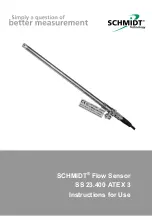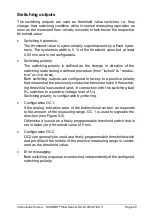
Instructions for Use
– SCHMIDT
®
Flow Sensor SS 23.400 ATEX 3
Page 8
Pipe-related flow
Installation in a flow-guiding pipe is carried out by means of a through-bolt
joint (532160, see also Figure 3-1):
Screw the threaded part of the through-bolt joint into the pipe union
(hexagon with AF27).
If pressure tightness is required, first, seal the thread (e.g. wrap it
with a teflon tape).
Unscrew the spigot nut (AF17) to such an extent that the sensor can
be inserted without jamming.
Remove the protective cap from the sensor tip and insert the sensor
into the bore of the DG so that its tip is in the middle of the pipe.
Tighten the spigot nut slightly by hand or with a fork wrench (AF17) to
fasten the sensor.
Align the sensor according to the nominal flow direction (direction of
the arrow) while the immersion depth must be maintained.
The angular deviation should not exceed
5° relatively to the
ideal position. Otherwise, the measurement accuracy may be
impaired.
To tighten the spigot nut, turn the fork wrench (AF17) a quarter of a
turn. While doing this hold the sensor to ensure that it remains in po-
sition.
To achieve the accuracy specified in the data sheets, the sensor has to
be positioned in a straight pipe section with undisturbed flow profile. An
undisturbed flow profile can be achieved if a sufficiently long distance in
front of the sensor (run-in distance) and behind the sensor (run-out dis-
tance) is held absolutely straight without disturbances (such as edges,
seams, bends etc.; see Figure 3-2).
Correct measurements require laminar
6
flow with turbulences as
low as possible.
The design of the run-out distance is also important, since disturbances
do not only act
in
the direction of the air flow but also lead to turbulences
against
the flow direction.
6
The term “laminar” means here an air flow low in turbulence (not according to its physical
definition saying that the Reynolds number is < 2300).
!
!























